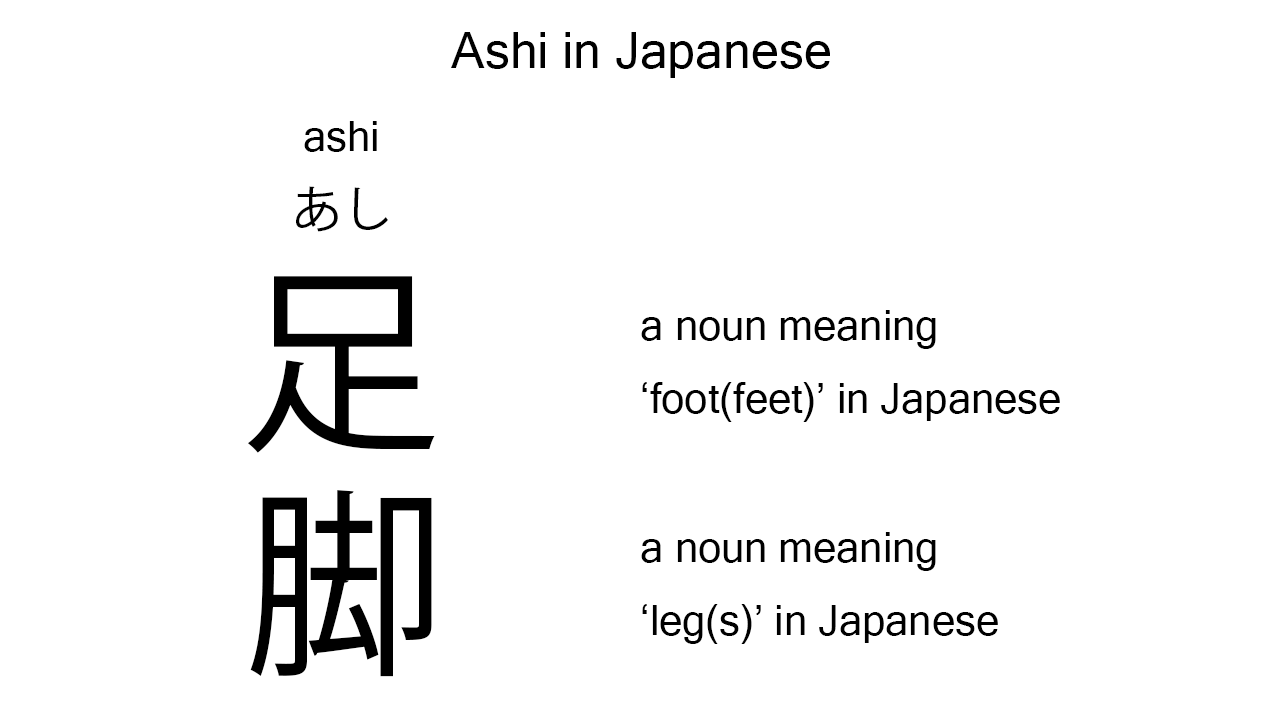What does “ashi” mean in Japanese?
Native speakers say “ashi” to mean ‘foot’ or ‘leg’ in Japanese. Perhaps, some Japanese learners know this word as it is sometimes used in Japanese conversations. In this blog post, however, I will explain it in detail together with its kanji expressions. And also, I will explain how to use it through example sentences. My explanations would help Japanese learners use “ashi” more properly. Then, let’s get started!
Contents
Definition and meanings of “ashi”
Let me start with the definition and meanings of “ashi”.
- ashi – 足/脚 (あし) : a noun meaning ‘foot’ or ‘leg’ in Japanese. This can also work as plural. Learn more about Japanese plural.
“Ashi” has two different kanji expressions. The first one means a ‘foot’ and the second means a ‘leg’ in Japanese. We need to use a proper one.

The definition and meanings are not that difficult, I think. Then, let me explain how to use this noun through the example sentences below.
Example #1: how to say “legs” in Japanese
boku no ashi wa totemo nagai – 僕の脚はとても長い (ぼくのあしはとてもながい)
My legs are very long.
Below are the new words used in the example sentence.
- boku – 僕 (ぼく) : a pronoun meaning ‘I’ in Japanese. This is used mainly by boys and young males.
- no – の : a case particle used after a noun or pronoun to make its possessive case. In the example, this is used after “boku” to make its possessive case, “boku no”, which means ‘my’ in Japanese.
- wa – は : a binding particle working as a case marker or topic marker. In the example, this works after “boku no ashi” to make the subject in the sentence.
- totemo – とても : an adverb of degree meaning ‘very’, ‘much’, or such in Japanese. In the example, this works in front of “nagai” to emphasize its meaning.
- nagai – 長い (ながい) : an i-adjective meaning ‘long’ in Japanese.
This is a typical usage of “ashi”. In this example, it works together with the possessive case, “boku no”, to say “my legs” in Japanese.
Example #2: another usage of “ashi”
watashi no ashi wa chiisaku te kawaii – 私の足は小さくて可愛い (わたしのあしはちいさくてかわいい)
My feet are small and cute.
Below are the new words used in the example sentence.
- watashi – 私 (わたし) : a pronoun meaning ‘I’ in Japanese. In the example, this works together with the case particle, “no”, to say “my” in Japanese.
- chiisaku – 小さく (ちいさく) : one conjugation of the i-adjective, “chiisai“, which means ‘small’ in Japanese. In the example, it has been conjugated for the better connection with its following word.
- te – て : a conjunctive particle used after a verb, adjective, or auxiliary verb to make its te form. In the example, this is used after “chiisaku” to make its te form, “chiisaku te”.
- kawaii – 可愛い (かわいい) : an i-adjective meaning ‘cute’ in Japanese.
This is another typical usage of “ashi”. In this example, it works as plural to mean ‘feet’ in Japanese.
Summary
In this blog post, I’ve explained the definition and meanings of “ashi” in detail together with its kanji expressions. And also, I’ve explained how to use it through the example sentences. Let me summarize them as follows.
- ashi – 足/脚 (あし) : a noun meaning ‘foot’ or ‘leg’ in Japanese. This can also work as plural. This noun has two different kanji expressions. The first one means a ‘foot’ and the second means a ‘leg’ in Japanese. We need to use a proper one.
Hope my explanations are understandable and helpful for Japanese learners.